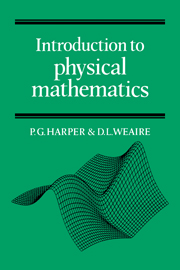Book contents
- Frontmatter
- Contents
- Preface
- Some notes on notation
- 1 Introduction
- 2 Errors
- 3 Cartesian coordinates
- 4 Vectors
- 5 The scalar product
- 6 The vector product and rotation
- 7 Matrices in physics
- 8 The transformation of matrices
- 9 The matrix eigenvalue equation
- 10 Exponential and logarithm functions
- 11 Sine and cosine functions
- 12 Graph plotting and curve sketching
- 13 Differentiation
- 14 Approximations
- 15 Power series and Taylor's expansion
- 16 Partial differentiation
- 17 Integration
- 18 The differential equation
- 19 Solving first-order differential equations
- 20 Second-order differential equations
- 21 Solving second-order differential equations
- 22 The complex exponential
- 23 The circuit equation
- 24 Harmonics and Fourier series
- 25 The diffusion equation
- 26 Waves
- 27 The rate of change of a vector
- 28 The scalar field and gradient operator
- 29 The vector field
- 30 Line integration
- 31 The potential field
- 32 Surface and volume integration
- 33 Flux and divergence
- 34 Circulation and the curl
- 35 Conclusion
- 36 Miscellaneous exercises
- Index
18 - The differential equation
Published online by Cambridge University Press: 20 October 2009
- Frontmatter
- Contents
- Preface
- Some notes on notation
- 1 Introduction
- 2 Errors
- 3 Cartesian coordinates
- 4 Vectors
- 5 The scalar product
- 6 The vector product and rotation
- 7 Matrices in physics
- 8 The transformation of matrices
- 9 The matrix eigenvalue equation
- 10 Exponential and logarithm functions
- 11 Sine and cosine functions
- 12 Graph plotting and curve sketching
- 13 Differentiation
- 14 Approximations
- 15 Power series and Taylor's expansion
- 16 Partial differentiation
- 17 Integration
- 18 The differential equation
- 19 Solving first-order differential equations
- 20 Second-order differential equations
- 21 Solving second-order differential equations
- 22 The complex exponential
- 23 The circuit equation
- 24 Harmonics and Fourier series
- 25 The diffusion equation
- 26 Waves
- 27 The rate of change of a vector
- 28 The scalar field and gradient operator
- 29 The vector field
- 30 Line integration
- 31 The potential field
- 32 Surface and volume integration
- 33 Flux and divergence
- 34 Circulation and the curl
- 35 Conclusion
- 36 Miscellaneous exercises
- Index
Summary
Differential equations are the very essence of much of mathematical physics. In the nineteenth century there was a tendency to replace them with equivalent ‘variational principles’. They have since reasserted themselves as the most convenient mathematical expression of many physical laws, at least in their application. Let us see how they arise in some simple examples.
An object, initially at temperature T0, is heated in the open air. How does its temperature T vary? That is, what is the function T(t)? As usual, we must first give a little thought to the physics of this situation. It may be assumed that there is a fixed ratio between the gain (or loss) of heat and the rise (or fall) of temperature, the ratio being the ‘heat capacity’ C of the object. Given this, the problem is attacked simply by identifying the mechanisms of heat gain/loss. Suppose heat is supplied by the heater at the rate Q(t) (not necessarily constant). From this we must subtract the rate of heat loss to the surrounding atmosphere, which clearly depends on the temperature T of the object – the hotter it gets, the greater the loss. A common assumption is the simple proportionality of this rate of heat loss and the excess of T over the temperature Ta of the surroundings.
- Type
- Chapter
- Information
- Introduction to Physical Mathematics , pp. 128 - 133Publisher: Cambridge University PressPrint publication year: 1985



